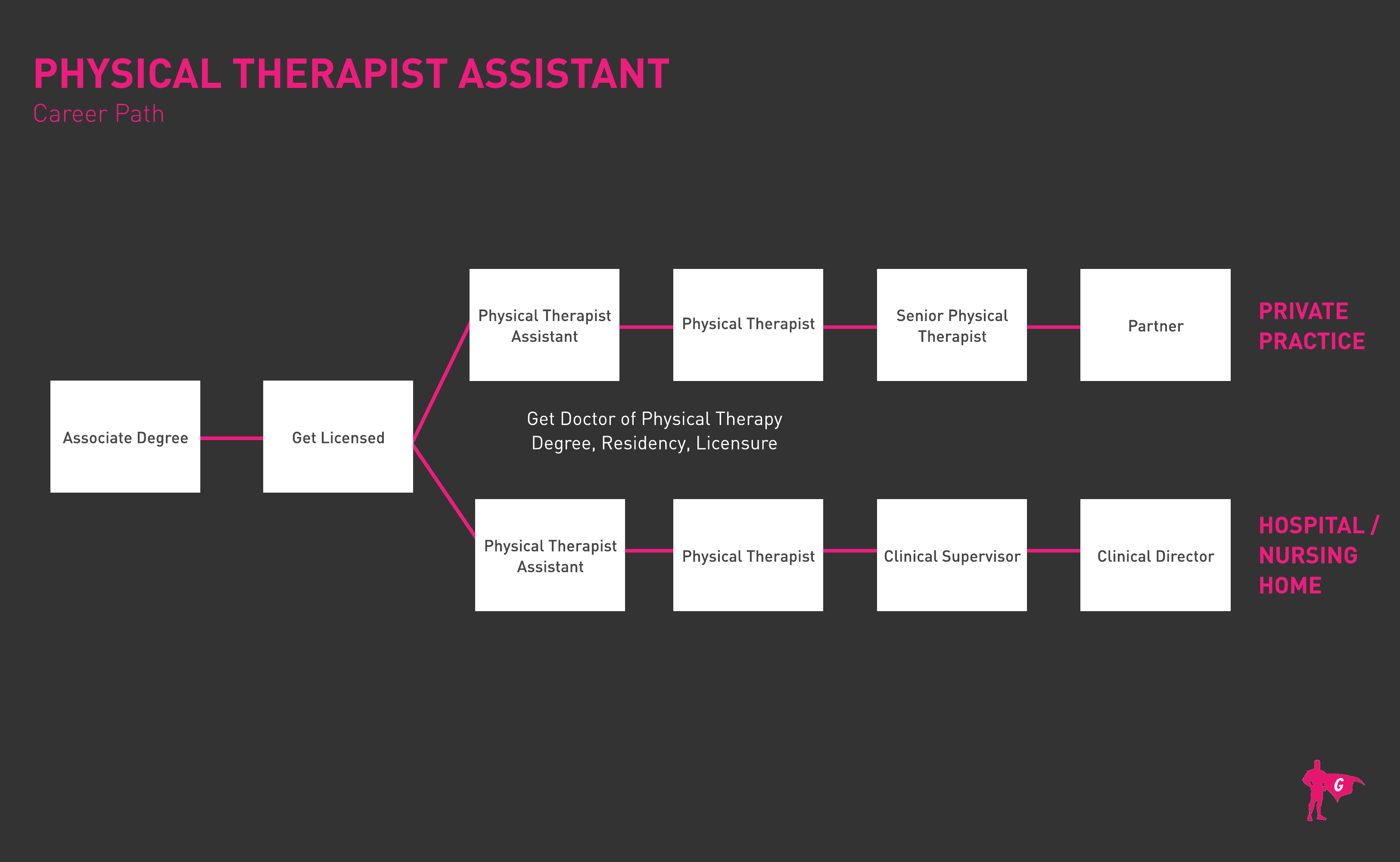Spotlights
Certified Physical Therapist Assistant (CPTA), Home Care Physical Therapy Assistant, Home Health Physical Therapist Assistant, Licensed Physical Therapist Assistant (LPTA), Licensed Physical Therapy Assistant, Outpatient Physical Therapist Assistant, Per Diem Physical Therapist Assistant (Per Diem PTA), Physical Therapist Assistant (PTA), Physical Therapy Assistant (PTA)
Physical therapist assistants help patients who have movement difficulties due to injury, surgery or disease, by assisting physical therapists with therapies to improve mobility, relieve pain, or limit permanent physical disability.
- Help people recover from injuries
- See progress through treatment
Physical therapist assistants typically do the following:
- Observe patients before, during, and after therapy, noting the patient’s status and reporting it to a physical therapist
- Help patients do specific exercises as part of the plan of care
- Treat patients, using a variety of techniques, such as massage and stretching
- Use devices and equipment, such as walkers, to help patients
- Educate patients and family members about what to do after treatment
- Offices of physical, occupational and speech therapists, and audiologists
- Hospitals - Outpatient clinics, Rehabilitation centers
- Nursing care facilities
- Home healthcare services
- Offices of physicians
- Sports training facilities
Click here to see how these different settings differ.
- Compassion
- Detail oriented
- Dexterity - use hands to provide manual therapy and therapeutic exercise
- Interpersonal skills
- Physical stamina
- Work nights and weekends
- On feet often to set up equipment and help treat patients
- Must lift and move patients
The demand for physical therapy is expected to increase in response to health needs of an aging population. Also, the number of chronic conditions have been more prevalent more recently. Physical therapists may use physical therapist assistants increasingly, especially in long-term care environments, to reduce the cost of services.
- Enjoyed helping people
- Enjoyed science and biology
- Played sports and was active
- Physical Therapist Assistants (PTAs) need at least an associate’s in Applied Science in Physical Therapist (or “Occupational Science, Physical Therapist Assistant”) to qualify for entry-level positions
- Note: Physical Therapy Aides are not the same as Assistants. Aides do not need a degree
- Programs should be accredited by the Commission on Accreditation in Physical Therapy Education
- Per the American Physical Therapy Association, common PTA classes include “anatomy, physiology, exercise physiology, biomechanics, kinesiology, neuroscience, clinical pathology, behavioral sciences, communication, and ethics/values.”
- ~25% of PTA training involves clinical practice
- Many earn certifications in cardiopulmonary resuscitation (CPR) and basic life support (BLS)
- PTAs can also become proficient in advanced areas, such as:
- Acute care
- Cardiovascular/pulmonary
- Geriatrics
- Neurology
- Oncology
- Orthopedics
- Pediatrics
- Wound management
- To obtain state licensure to work, grads must pass the Federation of State Boards of Physical Therapy’s National Physical Therapy Exam (NPTE)
- The Physical Therapist Assistant version of the NPTE features four sections, 200 questions, and takes up to 4.5 hours to complete
- PTAs also receive general On-the-Job training from their employers
- Many PTAs start a PT-related bachelor’s while they are working their day jobs. Options include a BS in Health Sciences or BS in Exercise and Sports Science
- Bachelor-level courses may include pharmacology, medical terminology, and technical writing, as well as training for manual therapy and electrotherapeutic modalities
- Holding a bachelor’s can help qualify workers for higher wages or promotions. It won’t qualify you to be a full-fledged Physical Therapist. PTs must complete a Doctorate of Physical Therapy degree
- Take college prep classes in high school, including anatomy, physiology, biology, math, English, and communications. Study hard to earn good grades so you can get accepted into a suitable college program
- Shadow or interview a working PTA
- Volunteer or intern in healthcare settings where you can learn about patient care
- Consider whether or not you want to pursue a bachelor’s, either before or after starting work as a PTA
- Read or watch interviews with PTAs and learn about their various daily duties, such as patient observation; demonstrating exercises, stretches, and equipment use; educating families; plus clerical and labor tasks
- Think about where you want to work. PTAs can work in PT/occupational therapy offices, but also in hospitals, doctors’ offices, nursing homes, extended care facilities, for home healthcare service providers, in schools, and in sports and fitness facilities! In fact, some perform “contract travel” work, moving every few weeks or months
- Learn about the specific licensure requirements for the state you plan to work in
- Stay out of trouble so you can pass the background check (if applicable)!
- Develop a personal workout schedule so you can stay in shape and help patients, when needed

- Pass the NPTE test and get certified in your state
- Build strong connections while doing clinical practice. Keep an eye open for future job opportunities!
- Look for jobs on Indeed, Simply Hired, Glassdoor, or other popular job portals
- Create a professional LinkedIn account and list all of your experiences
- Keep your social media professional, too. Potential employers may do a little online research about candidates
- Consider gaining advanced specialization knowledge via the American Physical Therapy Association to boost your credentials
- Note, per the Bureau of Labor Statistics, in the years to come PTA services will be increasingly needed to help America’s aging population as people live and stay active longer. Thus, geriatrics might be a specialization area to consider
- Go where the most PTA jobs are! The states with the highest concentration of jobs for Physical Therapist Assistants are Arkansas, Kentucky, Ohio, West Virginia, and Pennsylvania. The highest employment levels are in Texas, Florida, California, Ohio, and Pennsylvania
- Check out Physical Therapist Assistant resume templates for ideas on formatting and phrasing
- Review sample Physical Therapist Assistant interview questions
- Make sure to conduct a few practice mock interviews and remember to dress for interview success!
- Specialization through PTA Advanced Proficiency Pathways (APP) - Click here to learn more.
- Physical therapist: There are only two "bridge" educational program that formally incorporates the PTA's knowledge, skills, and experience into the curriculum - the University of Findlay in Ohio and The University of Texas Medical Branch at Galveston in Texas. Click here to learn more.
Websites
- American Board of Physical Therapy Residency and Fellowship Education
- American Board of Physical Therapy Specialties
- American Board of Wound Management
- American Kinesiotherapy Association
- American Physical Therapy Association
- Biofeedback Certification International Alliance
- Commission on Accreditation in Physical Therapy Education
- Federation of State Boards of Physical Therapy
- Hand Therapy Certification Commission
- Medical Exercise Training Institute
- National Physical Therapy Examination
- National Strength and Conditioning Association
- Physical Therapist Centralized Application Service
Books
- Dreeben-Irimia’s Introduction to Physical Therapy Practice for Physical Therapist Assistants, by Christina M. Barrett
- Essentials of Kinesiology for the Physical Therapist Assistant, by Paul Jackson Mansfield MPT and Donald A. Neumann PT Ph.D. FAPTA
- Physical Rehabilitation for the Physical Therapist Assistant, by Linda Monroe MPT OCS and Michelle
Newsfeed

Featured Jobs

Online Courses and Tools

Annual Salary Expectations
New workers start around $56K. Median pay is $64K per year. Highly experienced workers can earn around $76K.






